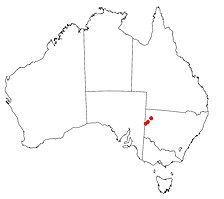
Agamidae is a family of over 550 species of iguanian lizards indigenous to Africa, Asia, Australia, and a few in Southern Europe. Many species are commonly called dragons or dragon lizards.

Ctenophorus is a genus of lizards, commonly known as comb-bearing dragons, found in Australia. They are in the dragon lizard family, known as Agamidae.
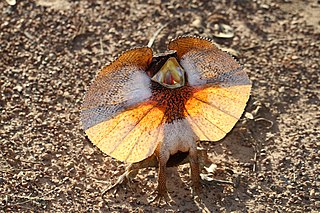
The frilled lizard, also known as the frillneck lizard, frill-necked lizard or frilled dragon, is a species of lizard in the family Agamidae. It is native to northern Australia and southern New Guinea. This species is the only member of the genus Chlamydosaurus. Its common names come from the large frill around its neck, which usually stays folded against the lizard's body. It reaches 90 cm (35 in) from head to tail and can weigh 600 g (1.3 lb). Males are larger and more robust than females. The lizard's body is generally grey, brown, orangish-brown, or black in colour. The frills have red, orange, yellow, or white colours.

The eastern bearded dragon, also known as common bearded dragon or simply bearded lizard, is an agamid lizard found in wooded parts of Australia. It is one of a group of species known commonly as bearded dragons. Other common names for this species include Jew lizard and frilly lizard, the latter being a confusion between this and another dragon, the frill-necked lizard. This species was originally described in 1829 by Georges Cuvier, who named it Amphibolurus barbatus.

The peninsular rock agama or South Indian rock agama is a common species of agama found on rocky hills in south India. An allied species, Psammophilus blanfordanus, is found in the Eastern Ghats, but north of the range of this species.

The yellow-footed rock-wallaby, formerly known as the ring-tailed rock-wallaby, is a member of the macropod family.

The Greek rock lizard is a species of lizard in the family Lacertidae. Endemic to Greece, its natural habitats are temperate forests, Mediterranean-type shrubby vegetation, rocky areas, and pastureland. It is threatened by habitat loss.The International Union for Conservation of Nature has listed it as being "near threatened".

The Peloponnese wall lizard is a species of lizard in the family Lacertidae. It is endemic to the Peloponnese region of southern Greece. Its natural habitats are Mediterranean-type shrubby vegetation, rocky areas, arable land, pastureland, plantations, and rural gardens.

Ctenophorus reticulatus, the western netted dragon or western netted ground-dragon, is a species of lizard in the family Agamidae. It is found in South Australia, Western Australia and southern Northern Territory.

The central netted dragon or central netted ground dragon is a species of agamid lizard occurring in a wide range of arid to semiarid regions of Australia. It is widespread across the continent, commonly found in open, sandy, desert habitats. It is a popular pet and can often be found in zoos.

Ctenophorus pictus, commonly known as the painted ground-dragon or painted dragon, is a species of lizard from the family Agamidae. It is endemic to the drier areas of southern and central Australia.
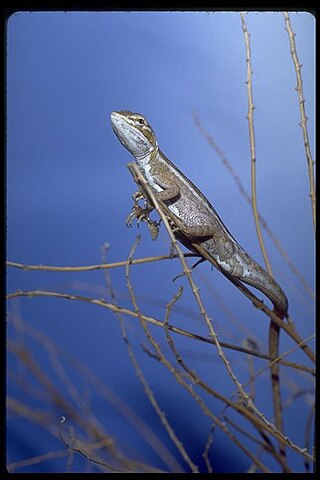
Diporiphora winneckei, also known commonly as the canegrass dragon, canegrass two-line dragon, blue-lined dragon, and Winnecke's two-pored dragon, is a species of small, terrestrial, diurnal lizard in the family Agamidae. The species is endemic to Australia. It is found throughout arid zones of Australia and is also a common house pet.

Ctenophorus fionni, also known commonly as the Arcoona rock dragon, the peninsula crevice-dragon and the peninsula dragon, is a species of lizard in the family Agamidae. The species is endemic to the Australian state of South Australia.
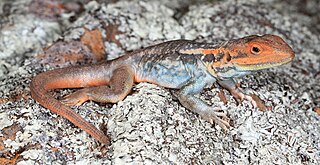
Ctenophorus decresii, also known commonly as the tawny dragon or the tawny crevice-dragon, is a species of lizard in the family Agamidae. The species is endemic to Australia. The average snout-to-vent length (SVL) of the species is 80.76 mm (3.180 in) with larger individuals being around 89 mm (3.5 in) and smaller individuals around 72 mm (2.8 in). The optimal time for mating in this species is two to three weeks after the females emerge from hibernation. Eggs are typically laid from September to October with most of them being laid earlier in the period. C. decresii is known for its variations in throat colors which change based on environmental conditions. Its primary food sources consist of both vegetation and invertebrates, and it prefers to live in rocky habitats.
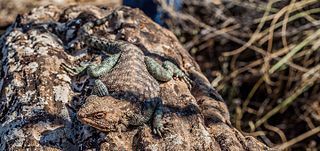
Agama bibronii, Bibron's agama or the North African rock agama, is a species of lizard belonging to the family Agamidae from north western Africa.
The gibber earless dragon also known as the smooth-snouted earless dragon, is a species of agamid lizard endemic to Australia. It is one of a documented species of the genus Tympanocryptis, a group of small terrestrial lizards that feed off invertebrates and are characterised by the absence of an external ear structure.

The Mallee military dragon, also commonly known as the Mallee dragon and the Mallee sand-dragon, is a species of lizard in the family Agamidae. The species is native to the arid parts of southern Australia.
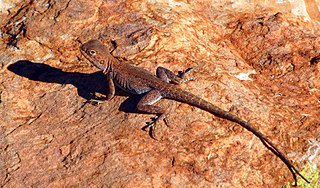
Ctenophorus caudicinctus, commonly known as the ring-tailed dragon or ring-tailed bicycle-dragon is a native species of agamid lizard occurring in rocky ranges and outcrops of Australia. Ctenophorus caudicinctus is most commonly found in the Pilbara region and offshore islands of Western Australia. The ctenophorus has 28 known species in the northern, southern, and western parts of Australia. It is recognized to be the most speciose group of Australian agamids.
Ctenophorus mckenziei, more commonly known as the dwarf-bicycle dragon, is a species of endemic Australian lizard within the family Agamidae and genus Ctenophorus. Originally identified as the agamid Amphibolurus mckenziei, the lizard had been identified within the regions of Western Australia and South Australia in which it occupied the shrubbery and woodland areas as its habitat. It was subsequently transferred to the genus Ctenophorus along with other Agamid species in which it shared similar morphology and characteristics. The name mckenziei is in reference to Norman Leslie Mckenzie, who was a zoologist and discovered the existence of the lizard. Listed on the IUCN red list page, threats to its population numbers are evaluated as least concern; however, their numbers are threatened by habitat loss, climate change, and feral predators.
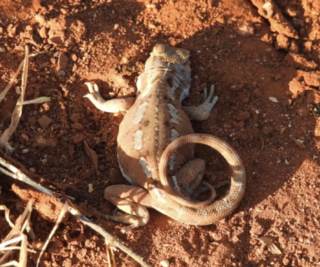
Ctenophorus parviceps, commonly known as the Gnaraloo heath dragon or northwestern heath dragon is a species of agamid lizard occurring in pale coastal sands and shell grit with open heaths and beach spinifex, between the North West Cape and Carnarvon, Western Australia and on Bernier Island. The Gnaraloo Heath Dragon is a lizard that can be found along the coast of Western Australia between Exmouth Gulf and Shark Bay, and is also known as the Northwestern Heath Dragon. It is native to Australia and usually inhabits sandy coastal dunes. The species’ longevity is 3–50 years and its population density is extremely low. The Gnaraloo Heath Dragon is a member of the Agamidae family, which contains 15 genera. The lizard is under the Ctenophorus genus which has up to 33 species. This genus shows the most morphological and ecological diversity out of the three large agamid genera. 83% of the lizards in this genus lack a crest, while 17% possess crests. They are smaller than most agamids but do have relatively large heads. The Gnaraloo Heath Dragon can be differentiated from related species by a series of spines on the tail's base, a pale-grey brown broad vertebral band along its back, and hour-glass bars extending upwards to meet the pale vertebral band. It is usually 45mm in terms of length, measuring from snout to vent.



